Sunset dancing insects, East Ruston, Norfolk.
The first owls are working the dusk
on the upper field,
flitting back and forth along the hedge,
desultory and conversational
their low-pitched calls,
their sudden clips and turns.
This is a moment’s grace, a stepping out
to gloaming, and the first breeze off the hills,
as I stand with my back to the wall
to feel the heat,
and listen, through the river of the trees,
for something of myself that waits to come,
as lyrical and poignant as the sound
of little owls and foxes on the hill
hunting for blood and warmth, in the yellow bracken.
John Burnside, September
Twilight by the lane at Witton, Norfolk.
Full Moon at Michaelmas
Unusually, I can begin this newsletter by wishing you a happy full moon AND a happy Michaelmas! We’ll talk a little about Michaelmas later, but let’s start with a chat about the names I’ve been able to discover that have been given to the September full moon.
The best known name for the September moon is the Harvest Moon which is beautifully evocative I always think. However - and I always learn something new when researching this part of the newsletter - technically the Harvest Moon is the full moon closest to the autumn equinox which always falls between 20 and 23 September. This means that while most years it is indeed the September full moon, around every three years the Harvest Moon falls in October.
Although Harvest Moon is the name you usually see cited, some of the Native American tribes called it the Corn Moon, for the time they harvested their corn. And it’s true that sweetcorn is one of the later crops to mature in the garden. I’ve also read that Celtic and Old English names are Wine Moon, Song Moon and Barley Moon. Fiona Walker-Craven gives the latter name for September in her book 13 Moons (out of print), although most other contemporary authors go with Harvest.
How about you? Looking around the land where you live, what would you call the September full moon? I thought of Stag Moon, as this is the time when I hear the first bellowings of the autumn rutting season, or perhaps Bracken Moon as the bracken on the heath begins to turn to gold and bronze. Or would you prefer to stay with Harvest Moon, the name that is so deeply etched on our collective sense of the turning of the year?
Contemporary stained glass in Edgefield church, Norfolk.
Weather Lore from the Wise-Woman’s Cottage
We haven’t heard from our Yorkshire wise-woman for a while, grandmother of author Claire Nahmad who has set down her evocative sayings in two of my favourite books, Earth Magic and Garden Spells. So, in her own words, here are a few pieces of autumnal weather lore that I hope will prove useful to you as we slide further into the dark half of the year.
When you see the cock and his hens all flocking together under some covert in the farmer’s yard, prepare to take shelter yourself, for as folk say, ‘the fowls can smell foul weather’.
When you hear the birds chirruping loudly in the rain, sounding light of heart as if they were up to some merriment, clear lovely weather will soon cheer your spirits.
When, upon the waters of a woodland pool or a pond in a meadow you see in the morning a little ball of mist like a wandering spirit, that is the water-sprite calling down the rain, and you must take care not to be caught without your bonnet. If the ball of mist floats up to heaven, the sun has called the water-sprite up to the moon to make a holiday for a little while, and no rain will be seen till he comes back down to work again.
When you see a spider busy spinning her web, be assured that fine weather is coming to stay awhile. If she changes her web between six and seven o’clock in the evening, expect a still and fine night.
Search among the grasses for clover leaves; if these be drawn closely together as if in a prayer, thunder and rain is coming on.
When the scent of flowers from the garden hangs sweet and heavy in the air and their perfume steals in at your doorway, you can be sure of rain sweeping in from the west before very long.
Changeable weather, Happisburgh beach, Norfolk.
A Lesson from a Stag
A year ago today, I began what I hoped would be a daily ‘nature pages’ practice. I decided that every day I would go out for a short walk down the lane and over the heath, and then write two pages in my notebook, stream-of-consciousness style. Letting the words flow freely would prevent any attempt by me to edit my work or make the writing ‘perfect’. Instead, it would just be a simple record of the way the seasons change almost imperceptibly day by day.
My plan was inspired by the annual London Writers’ Salon community invitation to finish the year strongly by setting a creative intention to be carried out over the 100 days before New Year’s Eve. Imagine the effect of spending, for example, just 10 minutes each day journalling or haiku-writing or making memoir notes or practising yoga or meditation! Counting back from 31 December, you come to 23 September which was the appointed starting date for the challenge. As I jumped in a little late, I decided to make 29 September - Michaelmas - my first day. To my delight, a quick calculation revealed that 100 days would bring me to another ancient festival, that of Epiphany on 6 January.
This all sounded wonderful in theory, but I found that as the days got shorter and the weather less clement, the idea of going out for a walk and getting back before 8am not only held less appeal, but often wasn’t especially practical as mist and rain drew a curtain over the cottage. So the project stalled until I revived it this spring, with the caveat that as the official project had come and gone, any day that I went out for a walk, came home and got some words down was something to celebrate.
And so, on the anniversary of its creation, I thought I would show you my very first day’s notebook entry. It’s no work of literature, but a year on I realise how much I value having this record. Perhaps you might think to do something similar, if you don’t already?
Below it I’ve linked a video I made at the time in which I tell the same story, so there’s a spoken version too.
I learned a lesson this morning that I hope to always remember and act upon. What I could have done, was to rush to the bedroom window as soon as I heard the unfamiliar sound. I should have been more curious. That’s the lesson. The sound I heard was footsteps, but not of human or dog. A little like horse hooves, but not quite. Lighter, more pit-pattery. I heard two more bursts of this in quick succession. Footsteps do ring and echo on the metalled lane so it’s hard to be certain but I was definitely aware that it was different from other passing sounds I’d heard.
And I didn’t get up to look.
Before my writing session at 8am there was just enough time for a quick walk to the end of the lane and back. Misty, with low sun coming through. Beautiful. Reaching the place where the heath begins on either side I glimpsed a sudden movement and flash of colour, half on the lane and half emerging from the gorse.
A stag.
He swivelled his great antlers towards me, froze, and before I could lift my camera he was gone.
(Notebook entry dated 29 September 2022: Michaelmas Day)
Michaelmas video, 2022.
Fleet in the forest,
leaf shaken, wild in the wood,
flowers tousled in his hair,
garlanded with laurel and with ivy,
the Green Grotesque swoops out of stone and timber.
Locked in a church boss
his eyes start with alarm
at his enclosure. Brown priests agreed
to give his effigy a place.
That would bring the gaffers in,
the maids with May bandeaus,
the mothers full of fears and needing cures.
They could turn an eye
towards the old religion
while they received the new.
Christ nailed to a tree would keep their reverence
front facing; they could fringe
the altar of the new covenant with evergreen
with rosemary to sprig the nosegays left
under the wood-man’s stare.
Needs are many and the winter cold,
best to placate all gods.
The Mediterranean Lord of Life
could promise them a warmer afterlife,
the Forest Sprite green leaves,
a yellow corn and a berried harvest.
Heather Harrison, Green Man
PS: I’m not sure that I agree with the explanation for the presence of the Green Man in Christian churches as presented here - in fact I increasingly feel there’s no one single ‘true' explanation - but I do love the imagery, and of course the words Forest Sprite :) What do you think?
Three Years Ago …
Cabin fever after days of wind and rain led me down the lane to the heath for a breath of fresh air. What treasures of autumn lay in wait there, ready to ambush me with their beauty. A carpet of acorns, vivid lime-green with the most unexpectedly pink ends where their caps had been attached. Cascading bryony garlands, draped around bony blackthorn necks. A huge toppled mushroom, breathtaking in its sculptural complexity. And this perfect spotted sphere, the darling of every enchanter.
Fly agaric in the alder carr along the lane.
Contours break the skin.
Acres of dust air
Drain from scraped fields:
White sheets bleaching to the hedge.
The rims harden
To bruised copper, violet,
Summer dead things,
A still shake of leaves.
East replies to West
In hems of ragged flame;
The darkening oils
Drift, merge, dissolve.
Ragnarok for the small gods.
Twilight wavers; cloaks
A shrivel of insects,
Morsels, burnt offerings.
And summer falls back, slips
Through policies of scorched earth.
Nostrils wince and prick
At charred roundels and striations.
An old ground-plan
Settles and clarifies
Land hurt and cleansed,
Picked to the black-bone.
Peter Scupham, Stubble Fires
Michaelmas
While I love the old festival of Michaelmas - one of the four Quarter Days in England along with Lady Day, Midsummer Day, and Christmas Day - I’ve been reading some dazzling explorations of its folklore and traditions and rather than repeating similar material, I will just point you in the direction of two of my favourite Substacks, Our Merry Folk and Hedge Mystic. There’s so much I could write about this most evocative of feast days (and I swooned to discover, just today, that High Angels’ Tide in Harvest is one of its alternative names) but truly it would merit a whole post to itself and that’s not the way this newsletter is shaping up, so I shall restrain myself!
I will just say, though, that Saint Michael can be a tricky one. Those of us who are partial to dragons may find it somewhat distressing to encounter images of the saint stamping triumphantly on a poor creature who is clearly on the point of being dispatched in a most unpleasant manner. One way of reconciling my natural sympathy for the dragon with the themes of Michaelmas is to interpret the scene as the promise that the warmth and light and fire and courage will prevail over the winter and spring will come again. I’ve heard, too, that Steiner schools encourage their pupils to think of dragons as challenging or unwanted habits and imagine themselves with the courage of Saint Michael to overcome their own.
Although the saint is often portrayed in very martial attire, some images bring out his elfin/angelic side and I can’t help finding these especially appealing. Apparently, medieval rood screen paintings of angels with feathery legs or bodies are actually mimicking the angel costumes that actors wore in mystery or mummers’ plays. The feathers (presumably laboriously sewn on individually) symbolised the otherworldly nature of these beings in contrast with the other more roundly human characters in the plays. Barton Turf and Ranworth churches in Norfolk both have lovely depictions of a very fey Saint Michael.
And while admittedly not connected with Michaelmas at all, I must put in a word for the wonderful Angel Gabriel on the screen in North Walsham who is dressed in silken finery - but if you look closely you see the telltale feathers peeking out underneath.
Saint Michael and his dragon on the rood screen at Ranworth, Norfolk.
Who knows what I’ve got
In my pot?
Warden Pears
All hot, all hot, all hot!
(Traditional street cry)
In the woodland garden of my cottage I have planted two pear trees, a ‘Beth’ and a ‘Doyenne du Comice’. Unlike the apple trees, they both set fruit in their first year and I watched, thrilled, as the tiny pears swelled and ripened. I started to think that, being late September, they might be ready to taste so I fought my way through the thistles, nettles and bindweed to the back of the garden to the place in the hedgerow where Beth has nestled herself in and oh! where the last time I’d looked there had been dozens of beautiful pears there was Not A Single One! And no trace whatever, no clue as to their fate. It’s not somewhere that humans could easily get to (including me!) even if the pears were ripe enough and it’s hard to believe that any creature could remove them so deftly and completely. It’s still a mystery.
But the Comice …. well, it may bear only a few fruits but still they swing there, plump and lovely. Could anything feel more perfect in the palm?
As it’s Michaelmas I thought I would share my adaptation of a traditional recipe for hot spiced warden pears, sold in medieval times as street food at this time of year. The name ‘Warden’ is thought to derive from the village of Old Warden in Bedfordshire, a county noted for its prolific orchards. The Old Shop’s garden is not quite in that league!
Looking back I was a strange teenager. I got excited even then about traditional customs marking each point in the yearly cycle. The original recipe for this Michaelmas fare comes from a book called Christmas and Festive Day Recipes which I was given for my 18th birthday. Then, I would have used butter and brown sugar rather than coconut oil and coconut sugar, and you can too if you prefer. The measurements are loose as the book fell apart from overuse many years ago.
Saint Michael’s Hot Spiced Pears
Peel and quarter (or slice) half a dozen firm pears. Poach gently in dry cider to cover, with about 50g coconut sugar, a tablespoon of coconut oil, nutmeg and cinnamon to taste. Serve hot, sprinkled with toasted desiccated coconut and/or orange zest (optional).
Doyenne du Comice pear tree in my garden.
And some time make the time to drive out west
Into County Clare, along the Flaggy Shore,
In September or October, when the wind
And the light are working off each other
So that the ocean on one side is wild
With foam and glitter, and inland among stones
The surface of a slate-grey lake is lit
By the earthed lightening of flock of swans,
Their feathers roughed and ruffling, white on white,
Their fully-grown headstrong-looking heads
Tucked or cresting or busy underwater.
Useless to think you'll park or capture it
More thoroughly. You are neither here nor there,
A hurry through which known and strange things pass
As big soft buffetings come at the car sideways
And catch the heart off guard and blow it open.
Seamus Heaney, Postscript
Michaelmas full moon, from my cottage.
Until next time.
With love, Imogen x
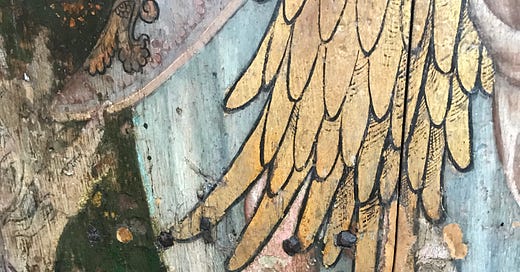



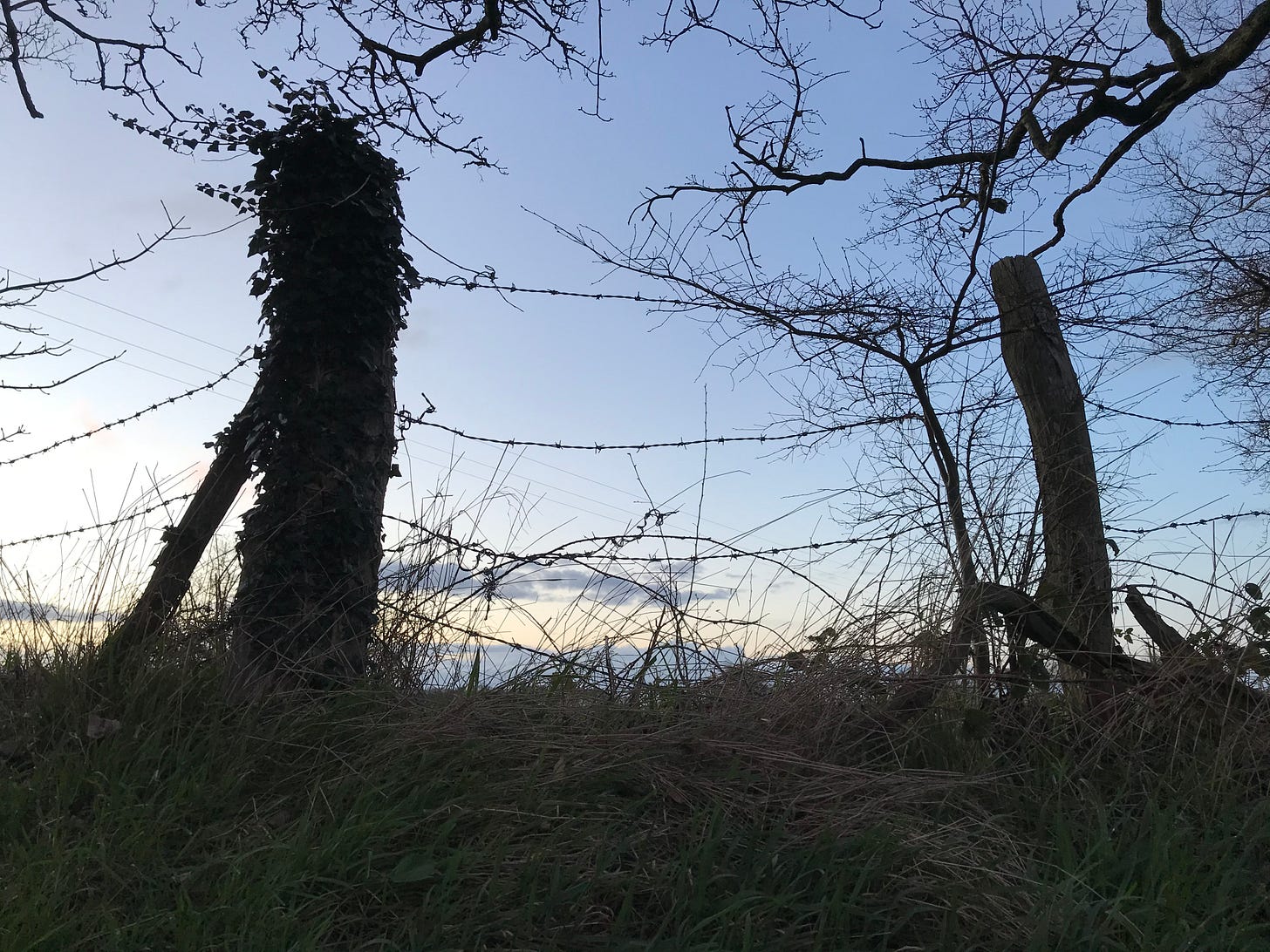
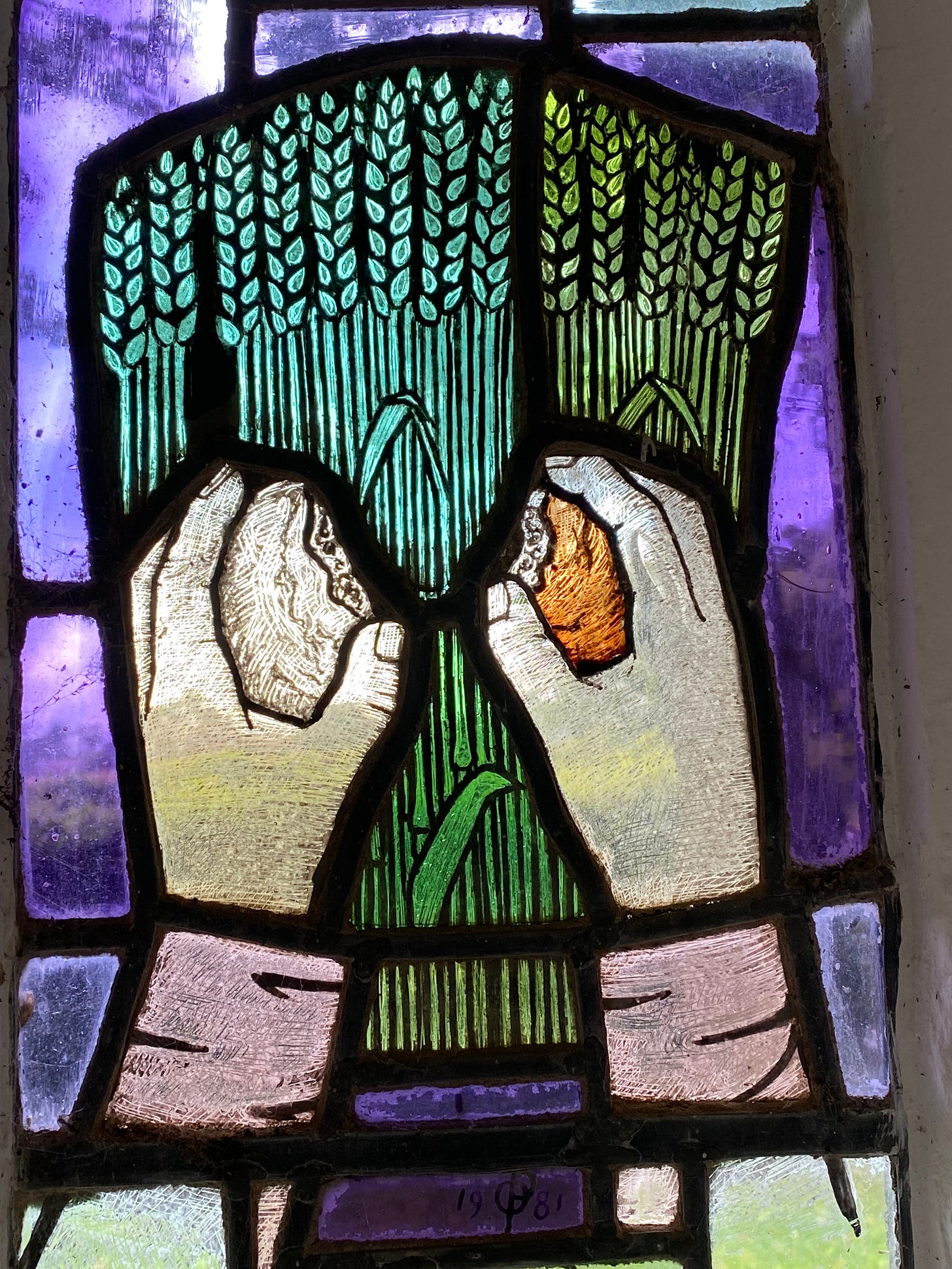
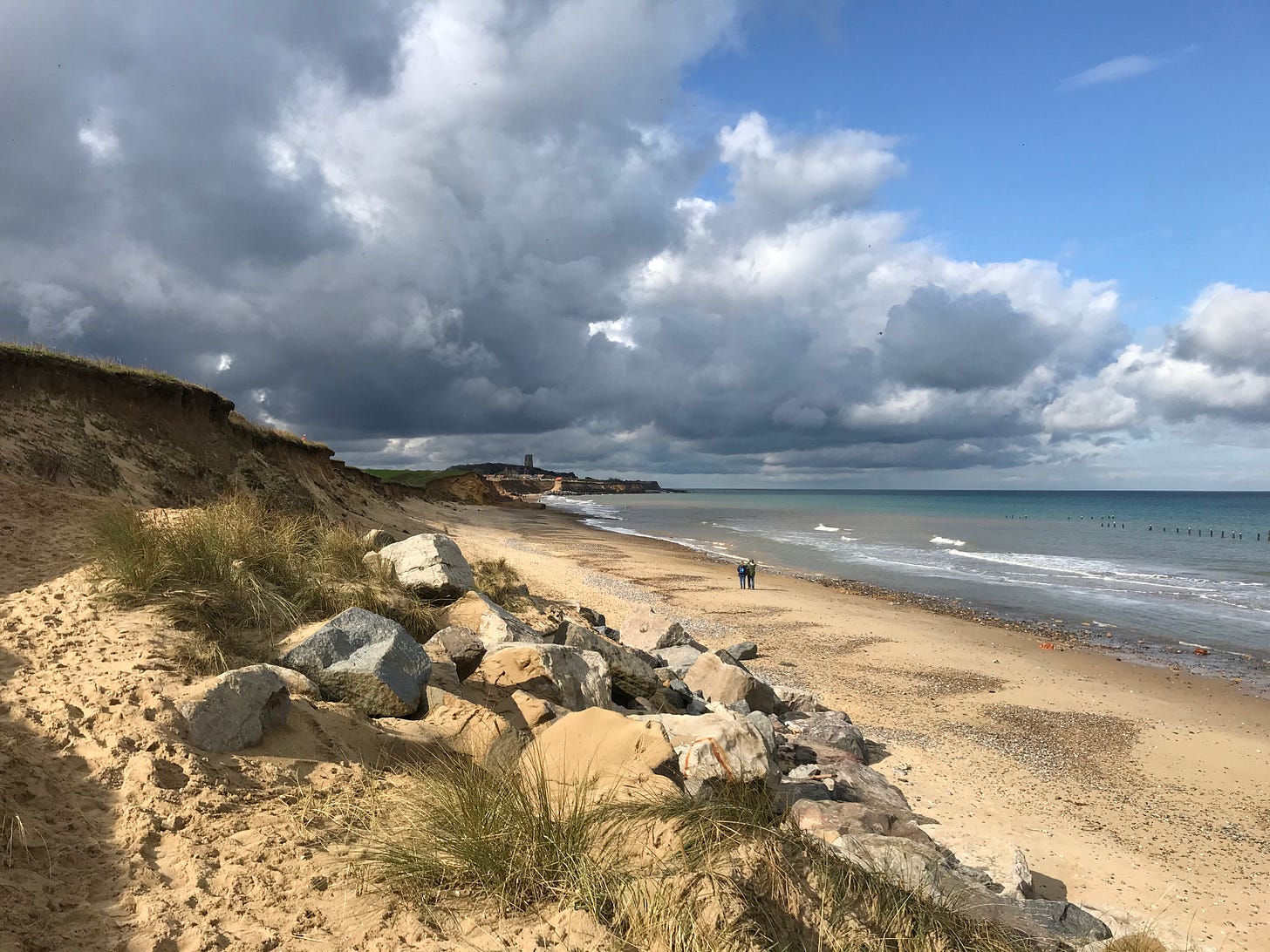
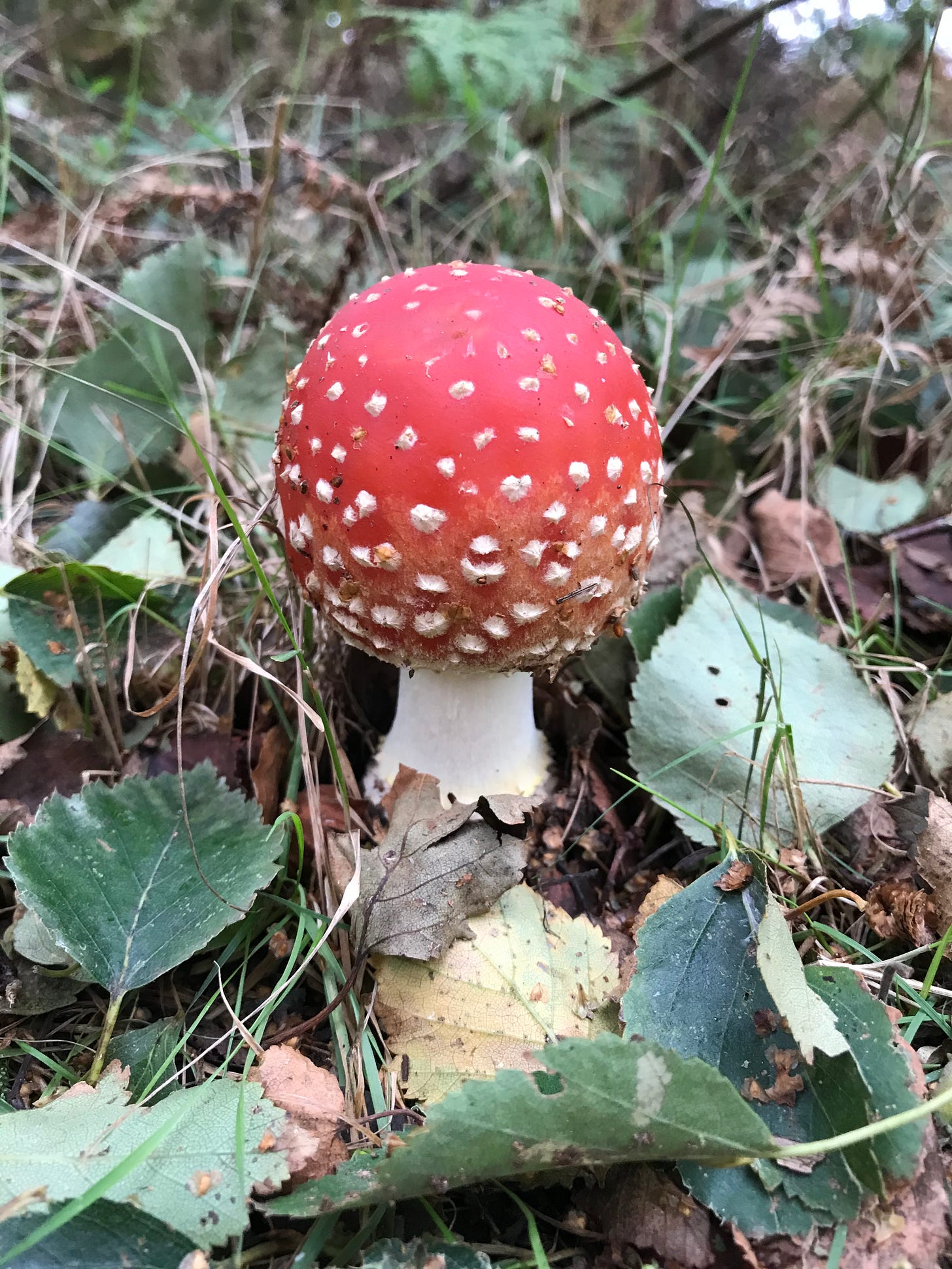
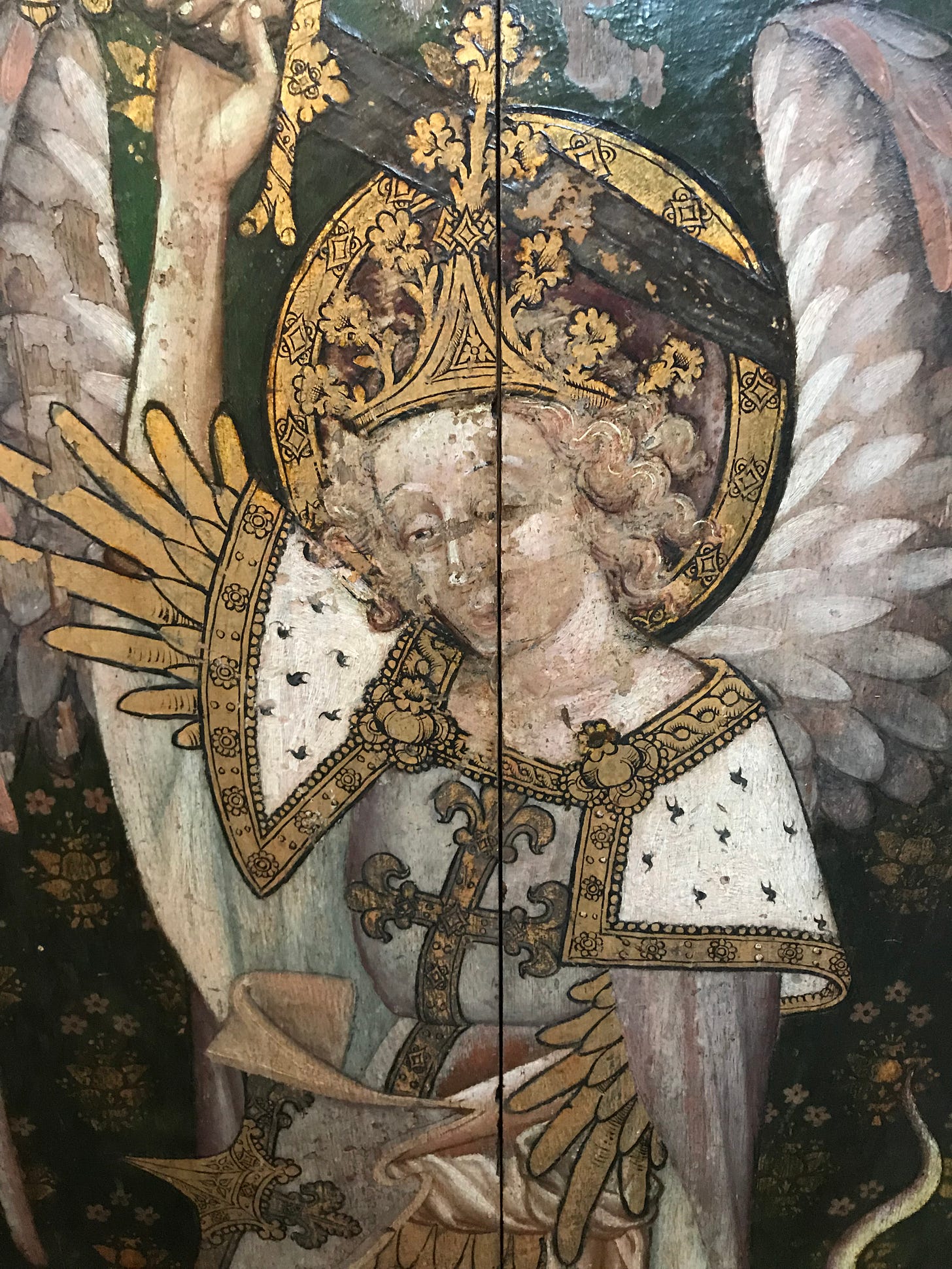

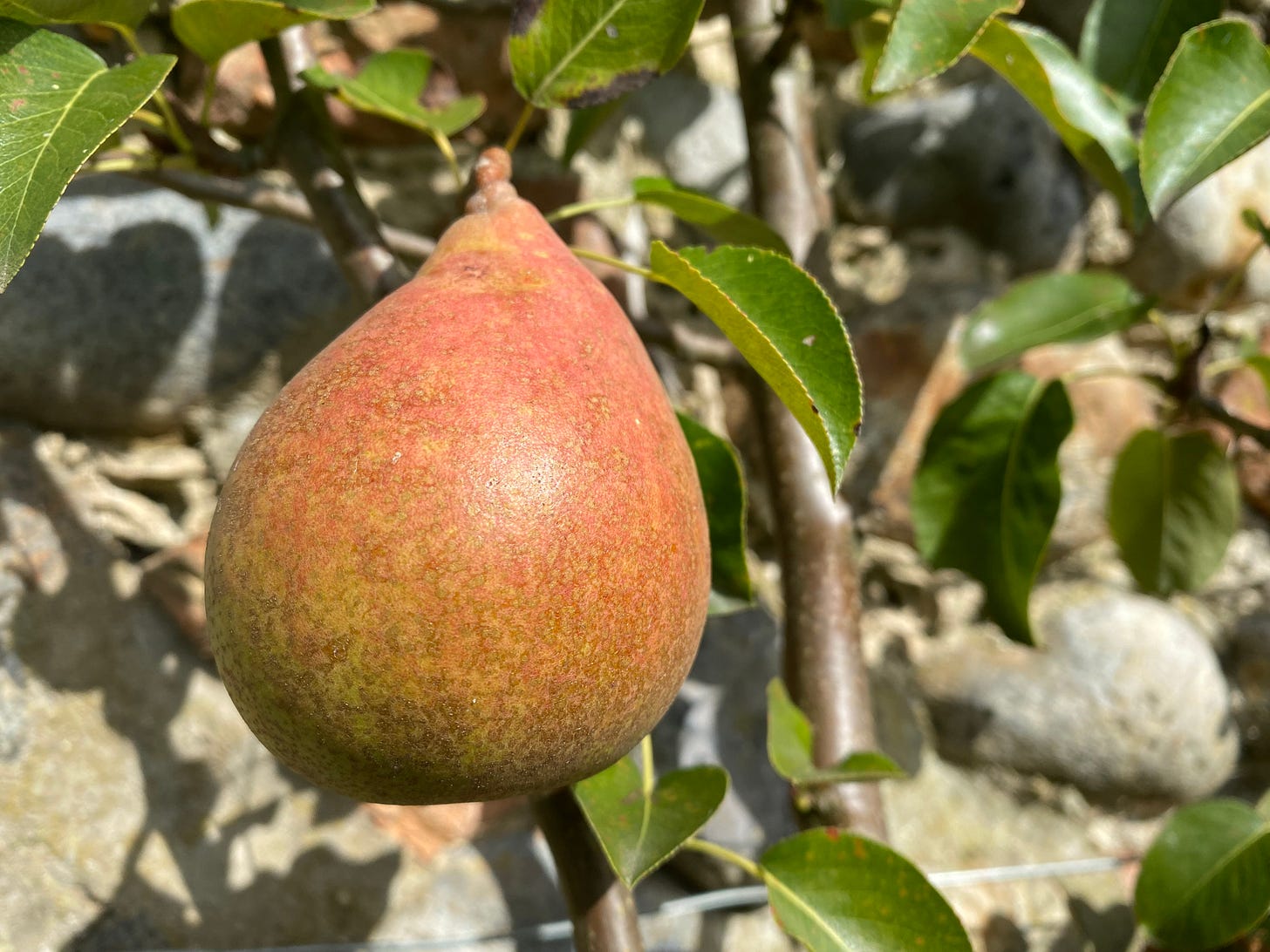
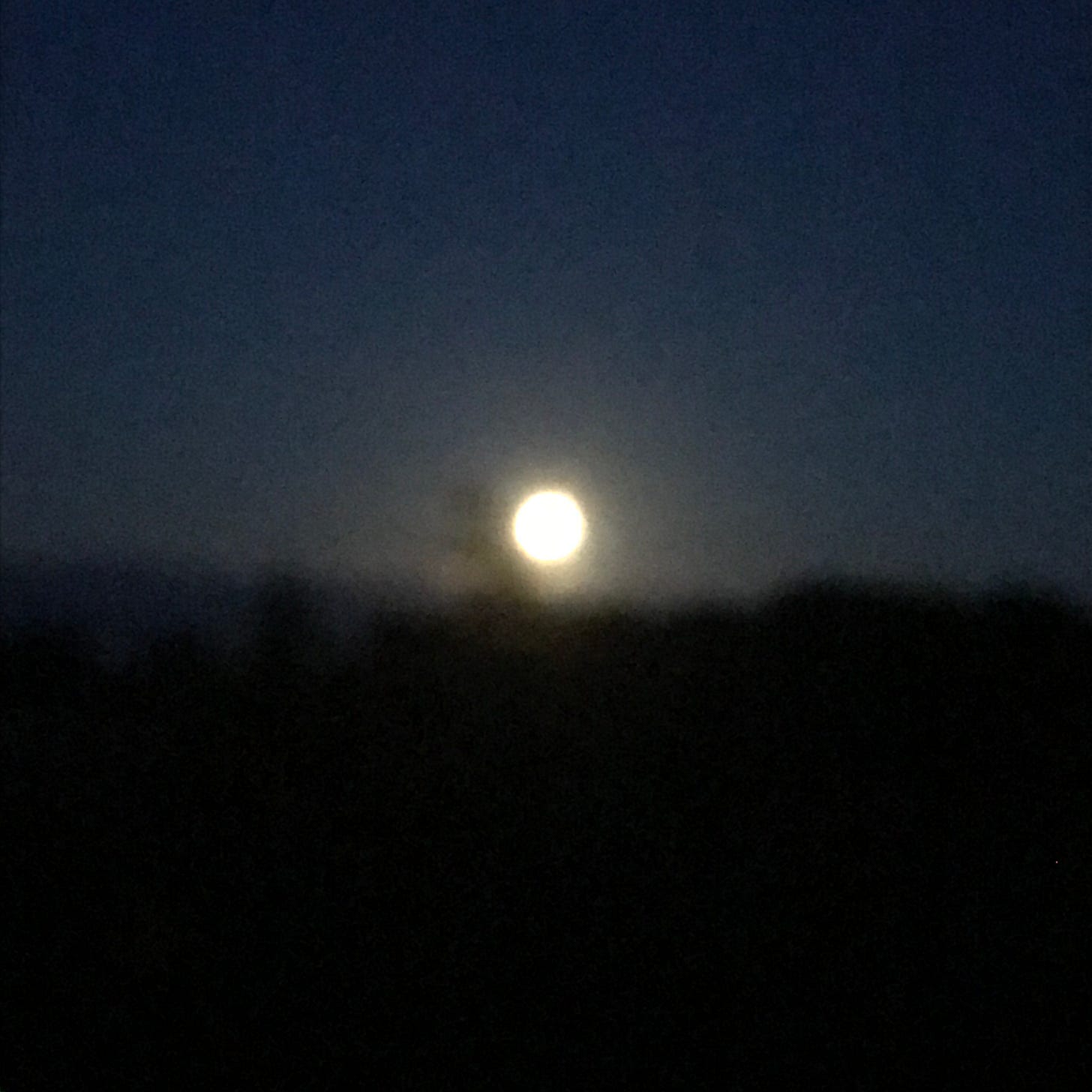
I just love your words Imogen 🙏🏻🩵
Your story of the stag reminded me of a time that I was awoken very early by the sound of hooves. And I did look out of my window into the dark and I saw a Victorian style hearse being drawn up my very steep city hill by a set of horses. Atleast I think I saw this, but I’m not entirely sure. It does seem quite unlikely. Maybe it was a dream. I will never know.